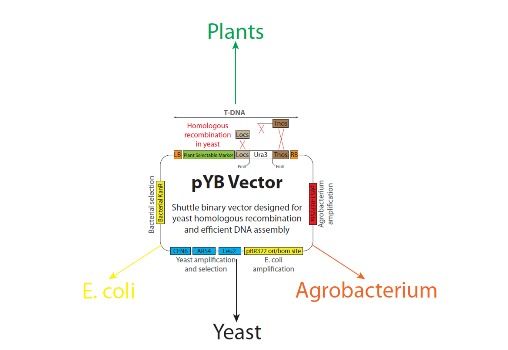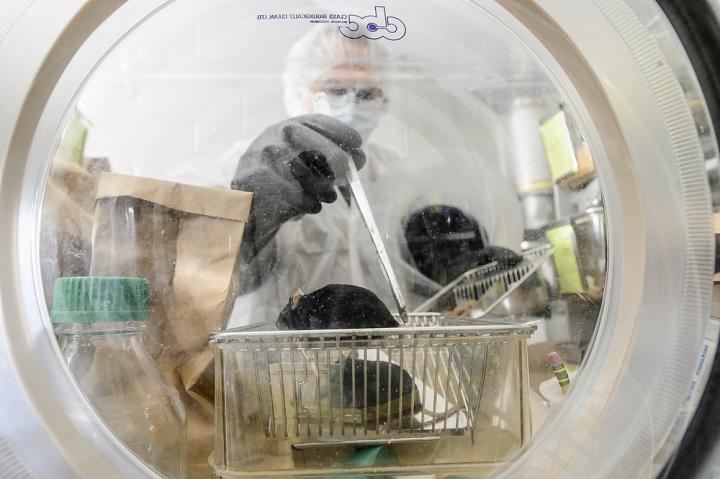Archive for the ‘food’ category: Page 298
Nov 25, 2016
New Plant Synbio Tool Breaks With Tradition
Posted by Karen Hurst in categories: bioengineering, biotech/medical, food
JBEI researchers develop efficient and affordable method for plant DNA assembly.
Researchers at the U.S. Department of Energy (DOE)’s Joint BioEnergy Institute (JBEI) in collaboration with Berkeley Lab’s Environmental Genomics & Systems Biology Division and the DOE Joint Genome Institute developed a versatile system (named jStack) which utilizes yeast homologous recombination to efficiently assemble DNA into plant transformation vectors. The new approach will impact plant engineering for the bioenergy, agricultural and pharmaceutical industries.
Although synthetic biology has provided solutions to many societal challenges, little research has been devoted to advancing synthetic biology in plants. Microbes, such as yeast and Escherichia coli (E. coli), have received much of the attention in developing synthetic biology tools due to their fast generation time and the ease of working with these organisms in laboratories. A shortage of characterized DNA parts, along with the difficulty of efficiently assembling multiple and large fragments of DNA into plant transformation vectors, has limited progress in studying and engineering plants to the same degree as their microbial counterparts.
Nov 25, 2016
Study: Ice Cream For Breakfast Boosts Brain Performance
Posted by Shailesh Prasad in categories: food, neuroscience
PHILADELPHIA (CBS) — All the years of your parents saying “NO” to ice cream for breakfast may have actually stunted your brilliance.
According to The Telegraph, a new study performed by Yoshihiko Koga, a professor at Kyorin University in Tokyo, revealed that eating a certain amount of ice cream immediately after waking up in the morning can actually make you smarter.
No, you did not misread that!
Continue reading “Study: Ice Cream For Breakfast Boosts Brain Performance” »
Nov 25, 2016
Changes in the diet affect epigenetics via the microbiota
Posted by Steve Hill in categories: biotech/medical, food, genetics, health
You get out what you put in.
You are what you eat, the old saying goes, but why is that so? Researchers have known for some time that diet affects the balance of microbes in our bodies, but how that translates into an effect on the host has not been understood. Now, research in mice is showing that microbes communicate with their hosts by sending out metabolites that act on histones—thus influencing gene transcription not only in the colon but also in tissues in other parts of the body. The findings publish November 23 in Molecular Cell.
“This is the first of what we hope is a long, fruitful set of studies to understand the connection between the microbiome in the gut and its influence on host health,” says John Denu, a professor of biomolecular chemistry at the University of Wisconsin, Madison, and one of the study’s senior authors. “We wanted to look at whether the gut microbiota affect epigenetic programming in a variety of different tissues in the host.” These tissues were in the proximal colon, the liver, and fat tissue.
Continue reading “Changes in the diet affect epigenetics via the microbiota” »
Nov 22, 2016
A synthetic biological metabolic pathway fixes CO2 more efficiently than plants
Posted by Karen Hurst in categories: biological, climatology, food, sustainability

In future, greenhouse gas carbon dioxide could be removed from the atmosphere by deploying a new biological method. A team headed by Tobias Erb, Leader of a Research Group at the Max Planck Institute for Terrestrial Microbiology in Marburg, has developed a synthetic but completely biological metabolic pathway based on the model of photosynthesis that fixes carbon dioxide from the atmosphere 20% more efficiently that plants can photosynthetically. The researchers initially planned the new system, which they presented in the magazine Science this week, on the drawing board and then turned it into reality in the laboratory.
Climate change is one of the most pressing challenges of our time. The concentration of carbon dioxide (CO2) in the atmosphere owing to human activities has continually risen since the start of the Industrial Revolution. All scientific evidence indicates that this increase is exacerbating the greenhouse effect and changing the climate. The consequences are already clearly evident. To overcome the environmental as well as the social challenge of climate change, “we must find new ways of sustainably removing excessive CO2 from the atmosphere and turning it into something useful,” underlined Erb, who leads a Junior Research Group at the Max Planck Institute in Marburg.
Continue reading “A synthetic biological metabolic pathway fixes CO2 more efficiently than plants” »
Nov 22, 2016
What are Molecular Machines?
Posted by Karen Hurst in categories: economics, evolution, food, information science, internet, nanotechnology, robotics/AI
Machines lace almost all social, political cultural and economic issues currently being discussed. Why, you ask? Clearly, because we live in a world that has all its modern economies and demographic trends pivoting around machines and factories at all scales.
We have reached the stage in the evolution of our civilization where we cannot fathom a day without the presence of machines or automated processes. Machines are not only used in sectors of manufacturing or agriculture but also in basic applications like healthcare, electronics and other areas of research. Although, machines of varying types had entered the industrial landscape long ago, technologies like nanotechnology, the Internet of Things, Big Data have altered the scenario in an unprecedented manner.
The fusion of nanotechnology with conventional mechanical concepts gives rise to the perception of ‘molecular machines’. Foreseen to be a stepping stone into nano-sized industrial revolution, these microscopic machines are molecules designed with movable parts that behave in a way that our regular machines operate in. A nano-scale motor that spins in a given direction in presence of directed heat and light would be an example of a molecular machine.
Nov 17, 2016
Genetic breakthrough: Crops use more sunlight to grow
Posted by Shane Hinshaw in categories: food, genetics
A genetic technique makes plants produce more food from sunlight — a key step in feeding the growing global population, scientists say.
Nov 10, 2016
Astronomers have designed a house for Mars — take a look inside
Posted by Klaus Baldauf in categories: food, habitats, space
Everyone from astronomers to tech companies wants to know what it would be like to live on Mars.
From growing vegetables in Martian soil, to claims that leaving Earth could save the human species, scientists are constantly making advances in this field.
Now, astronomers from the Royal Observatory in London and Stephen Petranek — author of “How We’ll Live on Mars” — have designed a Martian Show Home to demonstrate what life could be like on the Red Planet.
Continue reading “Astronomers have designed a house for Mars — take a look inside” »
Nov 9, 2016
Changing Cell Behavior Could be Useful for Stem Cell Research, Biofuel Production
Posted by Karen Hurst in categories: biotech/medical, food, genetics, sustainability
For example, ordinary baker’s yeast cells normally produce a lot of alcohol, a biofuel, when fed sugar extracted from the edible kernels of corn plants. NetSurgeon designed genetic surgeries that convinced the cells to make more alcohol when fed a type of sugar found in the inedible leaves and stalks.
The research is published in PNAS Early Edition.
Nov 7, 2016
Unless It Changes, Capitalism Will Starve Humanity By 2050
Posted by Amnon H. Eden in categories: business, climatology, existential risks, food, habitats, sustainability
The wealth gap worries Forbes, not your usual wide-eyed socialist.
How do we expect to feed that many people while we exhaust the resources that remain?
Human activities are behind the extinction crisis. Commercial agriculture, timber extraction, and infrastructure development are causing habitat loss and our reliance on fossil fuels is a major contributor to climate change.
Continue reading “Unless It Changes, Capitalism Will Starve Humanity By 2050” »
















